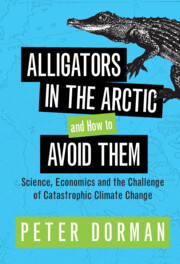 Alligators in the Arctic and How to Avoid Them
Alligators in the Arctic and How to Avoid Them Published online by Cambridge University Press: 14 July 2022
Voluntary or local renunciation of fossil fuels will not keep us within a carbon budget, and direct control along the lines of wartime rationing would be overbearing and inefficient. This leaves either carbon taxes or carbon permits as the main instrument. At a first approximation these are mirror images of each other: raising the price to reduce emissions or vice versa. Under uncertainty, however, taxes make prices predictable but leave emissions unpredictable, while permit systems do the reverse, which should be an argument for permits. Moreover, quantity controls better manage interdependent (multiple equilibrium) economic structures than price controls. Real-world implementation has been poor, as seen in the European Trading System and California’s Cap-and-Trade program. The culprits are weak targets, widespread exemptions, handouts to business and abundant offsets. The dismal experience of the Clean Development Mechanism shows that such offsets function mainly as loopholes. Better would be a system of permits with universal coverage, auctioned rather than given away, and not exchangeable for offsets. It should be accompanied by other policies to mitigate the distortions caused by rapid carbon price increases and to accelerate the development of non-carbon energy sources and non-carbon-using goods and services.
To save this book to your Kindle, first ensure [email protected] is added to your Approved Personal Document E-mail List under your Personal Document Settings on the Manage Your Content and Devices page of your Amazon account. Then enter the ‘name’ part of your Kindle email address below. Find out more about saving to your Kindle.
Note you can select to save to either the @free.kindle.com or @kindle.com variations. ‘@free.kindle.com’ emails are free but can only be saved to your device when it is connected to wi-fi. ‘@kindle.com’ emails can be delivered even when you are not connected to wi-fi, but note that service fees apply.
Find out more about the Kindle Personal Document Service.
To save content items to your account, please confirm that you agree to abide by our usage policies. If this is the first time you use this feature, you will be asked to authorise Cambridge Core to connect with your account. Find out more about saving content to Dropbox.
To save content items to your account, please confirm that you agree to abide by our usage policies. If this is the first time you use this feature, you will be asked to authorise Cambridge Core to connect with your account. Find out more about saving content to Google Drive.